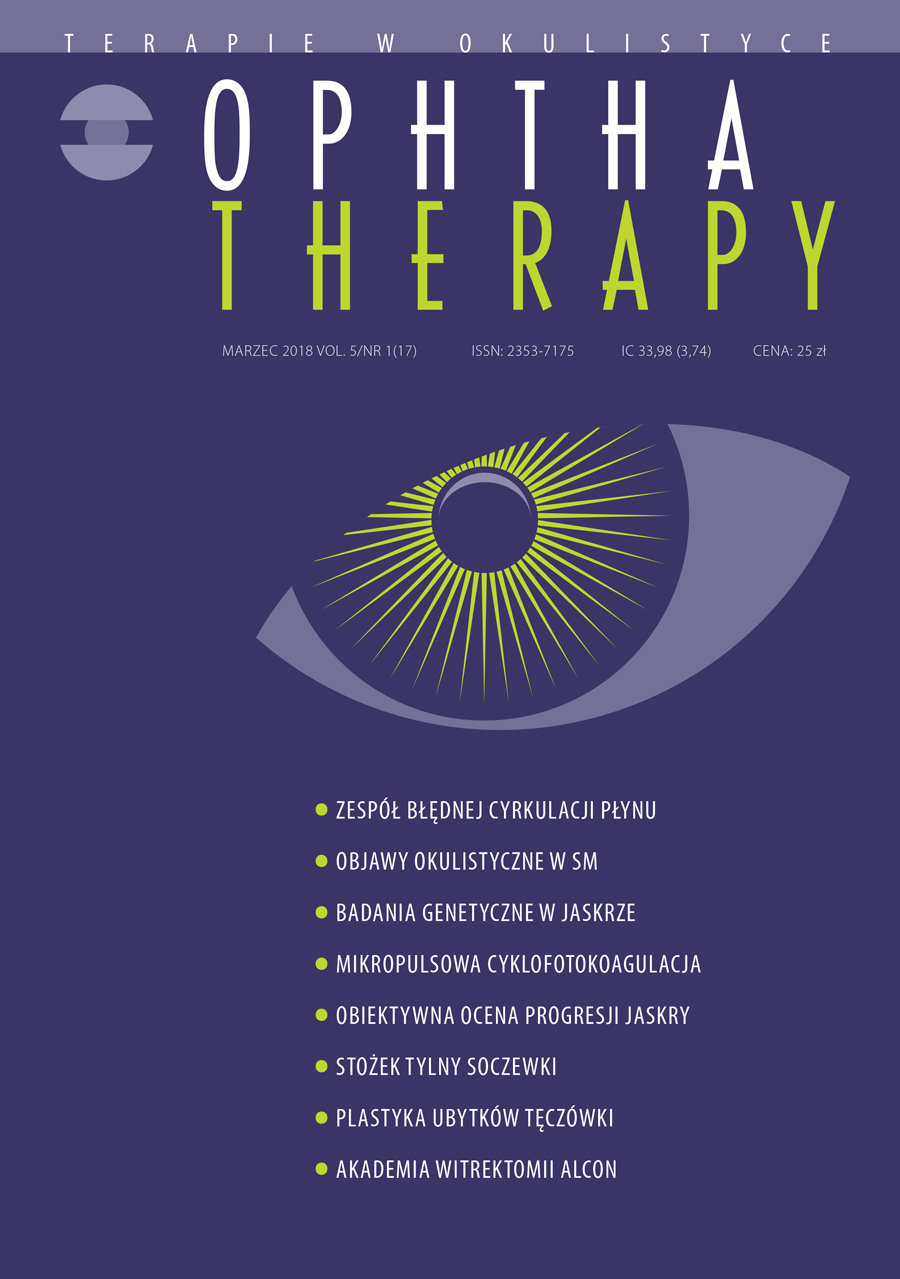Possibilities of micropulse cyclophotocoagulation application as a treatment option of patients with different glaucoma types
Main Article Content
Abstract
Micropulse cyclophotocoagulation, in contrast to the traditional method, is safe and does not induce cyclodestruction or significant inflammatory reaction. From over 60 patients treated in our Center in Cracow between June 2016 and December 2017, for retrospective analysis we took data of 12 patients (17 eyes) examined 12 months after surgery. There were 6 women and 6 men, between 33 and 85 years of age. In 6 patients it was secondary glaucoma, in 4 primary open angle and in 2 closed angle. Mean intraocular pressure decrease was 27% and in 8 eyes it was over 30%. No complications were observed and all patients were pain free and inflammation free during the follow-up.
Downloads
Article Details

This work is licensed under a Creative Commons Attribution-NonCommercial-NoDerivatives 4.0 International License.
Copyright: © Medical Education sp. z o.o. License allowing third parties to copy and redistribute the material in any medium or format and to remix, transform, and build upon the material, provided the original work is properly cited and states its license.
Address reprint requests to: Medical Education, Marcin Kuźma (marcin.kuzma@mededu.pl)
References
2. Aquino MC, Barton K, Tan AM et al. Micropulse versus continuous wave transscleral diode cyclophotocoagulation in refractory glaucoma: a randomized exploratory study. Clin & Experimental Ophthalmol. 2015; 43(1): 40-6.
3. Liu GJ, Mizukawa A, Okisaka S. Mechanism of intraocular pressure decrease after contact transcleral continous wave Nd: YAG Laser cyclophotocoagulation. Ophthalmic Res. 1994; 26: 65-79.
4. Tan A, Chockalingam M, Aquino M et al. Micropulse transscleral diode laser cyclophotocoagulation in the treatment of refractory glaucoma. Clin & Experimental Ophthalmol. 2010; 38(3): 266-72.
5. Lee N. Made-in-Singapore treatment for glaucoma more effective, has fewer side effects. The Straits Times. 24.05.2017.
6. Lin S, Babic K, Masis M et al. Micropulse transscleral diode laser cyclophotocoagulation: Short term results and anatomical effects. Poster 23 presented at: American Glaucoma Society 26th Annual Meeting; March 3-6, 2016; Fort Lauderdale, FL, USA.
7. Maslin JS, Chen P, Sinard J et al. Comparison of acute histopathological changes in human cadaver eyes after MicroPulse and continuous wave transscleral cyclophotocoagulation. Presented at: American Glaucoma Society 26th Annual Meeting; March 3-6, 2016; Fort Lauderdale, FL, USA.
8. Noecker RJ. Applying micropulse transscleral cyclophotocoagulation for early stage Glaucoma. Ophthalmology Times. 1 November 2017.
9. Toyos M, Toyos R. Clinical outcomes of micropulsed transcleral cyclophotocoagulation in moderate to severe glaucoma. J Clin Exp Ophthalmol. 2016; 7: 6.
10. Kuchar S, Moster M, Reamer CB et al. Treatment outcomes of micropulse transscleral cyclophotocoagulation in advanced glaucoma. Lasers Medical Science. 2016; 31: 393-6.
11. Mahootchi A. Modality approaches bilateral glaucoma in single treatment. Ophthalmology Times Europe. 2016; 12: 5-6.
12. Resende A, Moster M, Waisbourd M. A prospective pilot study evaluating the novel micropulse transscleral cyclophotocoagulation: short-term results. AGS abstract, San Diego, March 3-6, 2016.
13. Zagórski Z, Molęda-Gładysz K. Micropulse Transscleral CFC in the management of different glaucomas. Poster: 32 APAO Congress, Singapore, 1-5.03.2017.
14. Zagórski Z. Micropulse TCPC as a treatment option for a wide range of glaucoma patients. Presented at: ESASO Day Conference, Lublin, 24–25.11.2017.

